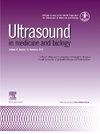Blood Flow Turbulence Measured by High-frame-rate Vector Flow Imaging Conduced to Investigating Advanced Carotid Plaque Vulnerability
IF 2.6
3区 医学
Q2 ACOUSTICS
引用次数: 0
Abstract
Objective
The high-frame-rate vector flow imaging (V Flow) technique is a simple, practical and feasible quantitative imaging method for detecting hemodynamic parameters of peripheral arteries in healthy people and patients with low carotid stenosis. However, whether V Flow can be used to assess hemodynamic parameters in patients with severe carotid stenosis remains to be illustrated. We sought to investigate the relationship between V Flow-evaluated hemodynamic parameters of advanced carotid stenosis and plaque composition and its value in assessing plaque vulnerability.
Methods
Patients undergoing carotid endarterectomy and ultrasound examination were collected, and plaque characteristics were graded on simple semiquantitative scales. Correlations between the turbulence index (Tur) and wall shear stress (WSS) in different parts of plaque and plaque components were analyzed. Receiver operating characteristic curves were used to analyze values of ultrasonic parameters in investigating plaque vulnerability.
Results
Tur was more severe in vulnerable plaque than in stable plaque (35.99 ± 26.17 vs 7.82 ± 8.41; p < 0.001). Plaques with severe Tur showed more intraplaque hemorrhage, thrombus, and thinner fibrous cap thickness (p < 0.05 for all). At the upstream sides of carotid stenosis, plaque with a lower mean WSS (meanWSSupstream) was associated with decreased fibrous tissue (p = 0.022). At the peak of carotid stenosis, meanWSS (meanWSSpeak) was higher in the plaques with intraplaque hemorrhage (p = 0.028) and intraplaque neovascularization (p = 0.037). Plaques with a higher oscillatory shear index of WSS had fewer lipid core (p = 0.029) thinner fibrous cap thicknesses (p = 0.004) and more intraplaque neovascularization (p = 0.032). The areas under the curves of carotid intima-media thickness, total plaque area (TPA), Tur, MeanWSSupstream, MaxWSSpeak, MeanWSSpeak, model 1, model 5 and model 6 for predicting plaque vulnerability were 0.804 (95% confidence interval [CI], 0.650-0.911), 0.886 (95% CI, 0.748-0.964), 0.843 (95% CI, 0.695-0.937), 0.733 (95% CI, 0.571-0.858), 0.677 (95% CI, 0.514-0.815), 0.672 (95% CI, 0.508-0.811), 0.895 (95% CI, 0.759-0.969), 0.973 (95% CI, 0.867-0.999) and 0.930 (95% CI, 0.805-0.986).
Conclusion
V Flow-detected hemodynamic parameters were related to plaque components and plaque vulnerability. V Flow has the potential to be an effective tool for investigating patients with severe carotid plaque.
高帧率矢量流成像测量血流湍流有助于研究晚期颈动脉斑块易损性。
目的:高帧率矢量流成像(V flow)技术是检测健康人及颈动脉低瓣狭窄患者外周动脉血流动力学参数的一种简单、实用、可行的定量成像方法。然而,V Flow是否可以用于评估颈动脉严重狭窄患者的血流动力学参数仍有待研究。我们试图研究V血流评估的晚期颈动脉狭窄血流动力学参数与斑块组成之间的关系及其在评估斑块易损性中的价值。方法:收集行颈动脉内膜切除术和超声检查的患者,以简单的半定量量表对斑块特征进行分级。分析了斑块不同部位及斑块成分的湍流指数(turr)与壁面剪切应力(WSS)的相关性。采用受者工作特征曲线分析超声参数值对斑块易损性的影响。结果:易损斑块的Tur比稳定斑块严重(35.99±26.17 vs 7.82±8.41;P < 0.001)。重度Tur斑块斑块内出血、血栓较多,纤维帽厚度较薄(p < 0.05)。在颈动脉狭窄的上游侧,平均WSS (meanWSSupstream)较低的斑块与纤维组织减少相关(p = 0.022)。在颈动脉狭窄的高峰期,斑块内出血斑块(p = 0.028)和斑块内新生血管形成斑块(p = 0.037)的平均wss (meanWSSpeak)较高。WSS振荡剪切指数越高的斑块脂质核心越少(p = 0.029),纤维帽厚度越薄(p = 0.004),斑块内新生血管越多(p = 0.032)。预测斑块易损性的颈动脉内-中膜厚度、斑块总面积(TPA)、Tur、MeanWSSupstream、MaxWSSpeak、MeanWSSpeak、模型1、模型5、模型6曲线下面积分别为0.804(95%可信区间[CI], 0.650 ~ 0.911)、0.886 (95% CI, 0.748 ~ 0.964)、0.843 (95% CI, 0.695 ~ 0.937)、0.733 (95% CI, 0.571 ~ 0.858)、0.677 (95% CI, 0.514 ~ 0.815)、0.672 (95% CI, 0.508 ~ 0.811)、0.895 (95% CI, 0.759 ~ 0.969)、0.973 (95% CI, 0.867 ~ 0.999)、0.930 (95% CI, 0.805 ~ 0.986)。结论:V - flow检测的血流动力学参数与斑块成分和斑块易损性有关。V流有可能成为一种有效的工具,用于调查严重颈动脉斑块的患者。
本文章由计算机程序翻译,如有差异,请以英文原文为准。
求助全文
约1分钟内获得全文
求助全文
来源期刊
CiteScore
6.20
自引率
6.90%
发文量
325
审稿时长
70 days
期刊介绍:
Ultrasound in Medicine and Biology is the official journal of the World Federation for Ultrasound in Medicine and Biology. The journal publishes original contributions that demonstrate a novel application of an existing ultrasound technology in clinical diagnostic, interventional and therapeutic applications, new and improved clinical techniques, the physics, engineering and technology of ultrasound in medicine and biology, and the interactions between ultrasound and biological systems, including bioeffects. Papers that simply utilize standard diagnostic ultrasound as a measuring tool will be considered out of scope. Extended critical reviews of subjects of contemporary interest in the field are also published, in addition to occasional editorial articles, clinical and technical notes, book reviews, letters to the editor and a calendar of forthcoming meetings. It is the aim of the journal fully to meet the information and publication requirements of the clinicians, scientists, engineers and other professionals who constitute the biomedical ultrasonic community.

 求助内容:
求助内容: 应助结果提醒方式:
应助结果提醒方式:


